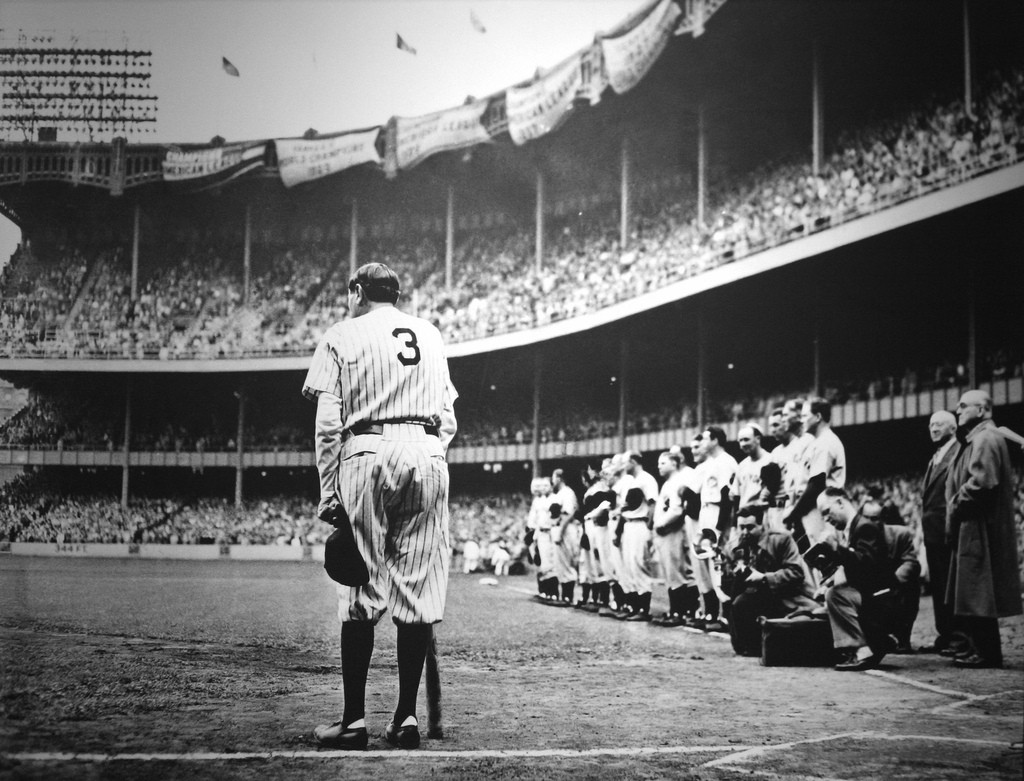George Herman Ruth, Jr. was better known as "The Babe" (or the Italian equivalent "The Bambino"). At the time of Ruth's trade from the Boston Red Sox to the New York Yankees for the 1920 season, the Bronx Bombers were playing home games in the Polo Grounds - a facility it shared with its owners - the New York Giants (oddly, the Giants organization owned the facility but not the land). Ruth's career (and the Yankees success) soared immediately, to the consternation of the Giants' leadership. After a little more than a season of seeing Ruth's popularity result in astronomical Yankee ticket sales, the Giants organization informed the Yankees that the team needed its own home. The seed for what would become Yankee Stadium was planted. On opening day in 1923, Ruth fittingly hit a home run to christen the new stadium, inspiring New York Evening Telegram sportswriter Fred Lieb to affectionately name the facility "The House That Ruth Built". Because Ruth's power hitting prowess, the consistent winning of the Yankees, the jealousy of the Giants organization, and Ruth's opening day bomb, Lieb's coined nickname for the new stadium was certainly rooted in accuracy.
On June 13, 1948, the Yankees were celebrating the 25th anniversary of Yankee Stadium and invited a sick and frail Babe for a curtain call. Ruth stood just inside the left-field line near the infield circle and infield grass. Facing fair territory, with his cap in his left-hand and a bat in his right-hand, a gaggle of photographers gathered along the right-field base line to snap a photo of the legendary Yankee. One photographer - Nat Fien (New York Herald Tribune) - positioned himself behind the left-field base line and forever immortalized The Bambino in the stadium he helped facilitate. This photo:

As has recently come to light, there was apparently a dispute (of sorts) between the estate of the photographer (Nat Fein) and the New York Times, Inc. regarding the ownership of this very famous photograph. Because Fein was working for a newspaper company that eventually became part of the NTY corporation, the newspaper company believed it was the owner of this photograph (Fein as an employee would have no ownership interest in works he created as part of his employment). However, the oft-invoked wrinkle rears its head here: before the NY Herald Tribune ceased operation, the photo editor physically transferred possession of the negative of this photo (and many others) to Fein.
However, the parties deprived a gawking-public of a potentially interesting bit of litigation in determining which group has the rightful claim to the photo (and the copyrights associated with the photo). Of several key pieces of missing (or omitted) information, it would be critical to know whether the NY Herald Tribune ceased operation prior to being acquired by the NYT (or alternatively, if the NYT acquired the Herald Tribune as it was closing shop, whether the acquisition agreement prohibited any transfer(s) of property without prior authorization, and if so, whether such authorization was secured).
Although the Herald-Tribune editor purportedly transferred the physical property (in the form of negatives) to Fein at some date in the past, the 1909 Copyright Act (as amended) would have controlled at whatever date this transfer occurred; and although less explicit than the language used in the 1976 Copyright Act, the 1909 Act does require a writing (with signature from the owner) to properly transfer ownership (under former section 28, and now embodied more explicitly in section 204 of the 1976 Act).
Another interesting aspect (that has a better chance of discovery, despite the oft-difficult search interface of the Copyright office's webpage and archives, is whether Fein, the NYT, or another entity renewed the copyright registration. Under the 1909 Act, copyright was registered for an initial term of 28-years and subject to a second (and final) renewal of an additional 28-years. Since the Fein photo was taken in 1948, the first 28-year term would have expired in 1976 and would have been subject to the renewal rules of the 1909 Act (as the 1976 Act would not become effective until Jan. 1, 1978). IF the renewal was not properly filed and/or granted, then the copyright in the photo would have expired and the photo would have become part of the public domain.
Perhaps this information was lost to history and necessitated the parties compromise and agree to this arrangement (with the NYT claiming ownership but with Fein's estate sharing in the revenue generated from sales of the famous photo).
Thus the advice: get everything in writing to avoid such ambiguities and disputes.